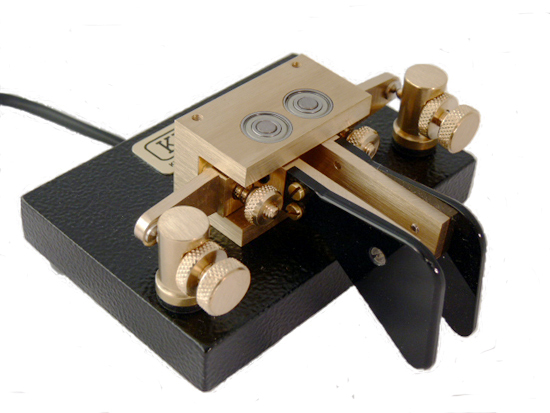 |
| Reports received with 50mW on 40m |
26 Feb 2013
40m WSPR with 50mW - best DX spot 6505km
25 Feb 2013
Bug keys
 |
| Kent twin paddle key |
Some years ago I bought a beautifully made Kent paddle key but I've hardly ever used it because I kept making mistakes. So, today I dug it out and decided to persevere with it on 40m CW. I managed a nice (unexpected) 2-way QRP QSO with Rick DK4QK who, despite my sending, managed to copy everything. Later I worked DM0E on 2-way QRP as well, using the bug. Like all things, good CW comes with practice and use. Using a paddle key should allow me to send better and faster CW with a little bit more practice on my part.
So, if you hear me calling CQ on 40, 20 or 10m in the coming days on CW, and there are plenty of mistakes and extra dots, then you'll know who it is.
20m WSPR
As the weather is totally miserable I decided to sit by the fire today instead of doing any amateur radio building. In the comfort of the lounge I am watching the spots being sent and received with 2W to the Par 10/20/40 end-fed antenna on 20m WSPR. 20m is not a band I use much, preferring 10m, although conditions on 10m have nothing like matched the conditions close to past sunspot maxima.
 |
| Some decent range spots (TX and RX) despite lackluster conditions on 20m |
Exchange rate changes and ham rigs
In recent weeks the pound sterling has declined quite a bit against the US dollar and the euro. Against the dollar it has fallen from around 1.62 dollars to the pound to around 1.51 to the pound. This makes purchases of rigs like the KX3 even more expensive here in the UK.
On the other hand, the yen has weakened from 125 to the pound to around 142 to the pound. Expect some discounting of Japanese rigs in the UK incoming months. The latest yen exchange rate suggests a new FT817ND should be less than £500 again soon.
Which major dealer will be really public spirited and pass on their savings to us the amateur radio public? Martin Lynch or Waters and Stanton?
On the other hand, the yen has weakened from 125 to the pound to around 142 to the pound. Expect some discounting of Japanese rigs in the UK incoming months. The latest yen exchange rate suggests a new FT817ND should be less than £500 again soon.
Which major dealer will be really public spirited and pass on their savings to us the amateur radio public? Martin Lynch or Waters and Stanton?
Labels:
exchange rate
24 Feb 2013
A PSK31 QSO
Well, the little grandchildren have gone back home to mum and dad so the house is very quiet (and tidy!) again. This afternoon I decided to do a bit of QRP on 20m as a change. First a nice 2-way QRP QSO with Emi IZ4RDX who was running 5W (me 2.5W) and then a PSK31 QSO with Luis EA3UV. Neither contacts were great DX, but fun. For the PSK31 QSO I decided NOT to use those pre-prepared messages and instead just keyed in what I wanted to say as the QSO went along. It felt like a real QSO, which was nice.
Tomorrow I hope to get back to the optical beacon work, but after 4 days of (lovely) little grandchildren this afternoon I just needed to "chill" as they say. The plan is to build a beacon TX that will allow a range of subcarriers and also continuous subcarrier transmission as well as CW and QRSS beacon messages. I hope to get out "over the horizon" looking for the signal later in the week. Watch this space - literally if you are nearby, HI.
Tomorrow I hope to get back to the optical beacon work, but after 4 days of (lovely) little grandchildren this afternoon I just needed to "chill" as they say. The plan is to build a beacon TX that will allow a range of subcarriers and also continuous subcarrier transmission as well as CW and QRSS beacon messages. I hope to get out "over the horizon" looking for the signal later in the week. Watch this space - literally if you are nearby, HI.
22 Feb 2013
PSK31 mode
Julian G4ILO mentions his enjoyment of PSK31 on HF on his blog today. Although I've had a fair few QSOs and some good DX with this mode over the years, I'm not a great fan of it.
Although Julian rightly says it is a very good mode that well complements CW and SSB, and it is certainly true that the PSK31 part of the bands are often busy when CW and SSB signals are absent, to me QSOs feel too formalised with exchanges that follow fairly standard formulae. Too often it feels like a PC talking to a PC. Maybe I should try next time to avoid using these pre-programmed messages and go for a normal free-form keyboard "chat" instead.
It's a while since I've tried PSK31 on HF. Maybe next week when the grandchildren go home I'll give it another go.
The ARRL reports that Varicode, as used in PSK31, has now been officially recognised by the ITU. See http://www.arrl.org/news/amateur-created-varicode-adopted-as-itu-recommendation .
Although Julian rightly says it is a very good mode that well complements CW and SSB, and it is certainly true that the PSK31 part of the bands are often busy when CW and SSB signals are absent, to me QSOs feel too formalised with exchanges that follow fairly standard formulae. Too often it feels like a PC talking to a PC. Maybe I should try next time to avoid using these pre-programmed messages and go for a normal free-form keyboard "chat" instead.
It's a while since I've tried PSK31 on HF. Maybe next week when the grandchildren go home I'll give it another go.
The ARRL reports that Varicode, as used in PSK31, has now been officially recognised by the ITU. See http://www.arrl.org/news/amateur-created-varicode-adopted-as-itu-recommendation .
More VLF activity from Germany
DJ8WX has been experimenting with a new GPS locked frequency source and is trying to put a signal out on 8.9700000kHz. The signal has been received strongly by several stations including Paul Nicholson in Todmorden and at PA1SDB. This is the signal at PA1SDB over the last few days. Note the timescale on Peter's grabber covers several DAYS. Such is the world of amateur VLF!
 |
Signal from DJ8WX now on 8.970000kHz (was 8.970022kHz)
|
Labels:
dj8wx,
dreamers band,
pa1sdb,
vlf
19 Feb 2013
Nanowave over the horizon tests - nearly ready
| Original optical beacon |
| Optical beacon capable of continuous subcarrier (choice of freqs) or QRSS/CW |
 |
| SpectrumView in action - it's brilliant |
I also want to optimise the use of the iPod Touch 4g as a handheld audio spectrum analyser. I have used it for this sort of test before using an excellent package available free called SpectrumView (see screenshot) available from Oxford Wave Research. With a laptop PC, running Spectran, the problem is the brightness of the screen which emits an interfering optical signal. With a tiny iPod Touch it is much less bright and can be held in the hand. Unfortunately the bandwidth can't be screwed down as narrow as with Spectran on the PC, so there will be S/N limitations. One test will be to see how far away I can detect my beacon (about 0.5W into the LED) over the horizon using just the optical receiver and the iPod Touch.
The beauty of 481THz (red light) work is the kit is simple: everything that matters is at audio frequencies and can be built and tested with the simplest of test gear.
Labels:
481thz,
nlos,
optical,
oxford wave research,
spectrumview
18 Feb 2013
Trio TR2300 1W 2m FM portable
Looking on eBay today I noticed someone selling an old Trio-Kenwood TR-2300 2m FM portable. I'd forgotten I owned one of these back in the 1980s. When it came out, it was one of the first synthesised 2m radios available.
I had it to get on 2m FM from home mainly. A small vertical dipole was erected at gutter height and with this set-up I could work well equipped stations out to around 50-60 miles. It was actually a rather good little radio that also got used in the car on holiday in France with my French call F0HXF.
Why it was sold I cannot remember. Of course, these days you get all the functionality, and a lot more, in a tiny handheld like the VX3 and the FT817 produces more than 6dB more power on all bands and modes from 160m-70cm in a box about 30% smaller.
Incidentally with 2 days to go there have already been 31 bids, so someone must want one.
I had it to get on 2m FM from home mainly. A small vertical dipole was erected at gutter height and with this set-up I could work well equipped stations out to around 50-60 miles. It was actually a rather good little radio that also got used in the car on holiday in France with my French call F0HXF.
Why it was sold I cannot remember. Of course, these days you get all the functionality, and a lot more, in a tiny handheld like the VX3 and the FT817 produces more than 6dB more power on all bands and modes from 160m-70cm in a box about 30% smaller.
Incidentally with 2 days to go there have already been 31 bids, so someone must want one.
ARRL DX CW contest
Until I read about it on G4ILO's blog, I'd quite forgotten about this big contest. Rather late on Sunday afternoon and evening I decided to have a go and see what could be worked on 40 and 20m. Although I managed a few US contacts with the 2.5W QRP I do find CW contests hard work: people send SO fast and by the time I've called with my straight key they've usually already had another QSO. I suspect many these days use keyboards and auto keyers most of the time in contests. Actually I quite enjoy the odd SSB contest as I can talk (nearly) as fast as anyone else. Even with 2.5W SSB it is surprisingly easy to make contacts in a big contest, especially late in contests when the big guns are looking for new stations to work. Overall, I prefer experimentation, but a contest just for fun can be quite cathartic.
Subscribe to:
Posts (Atom)




